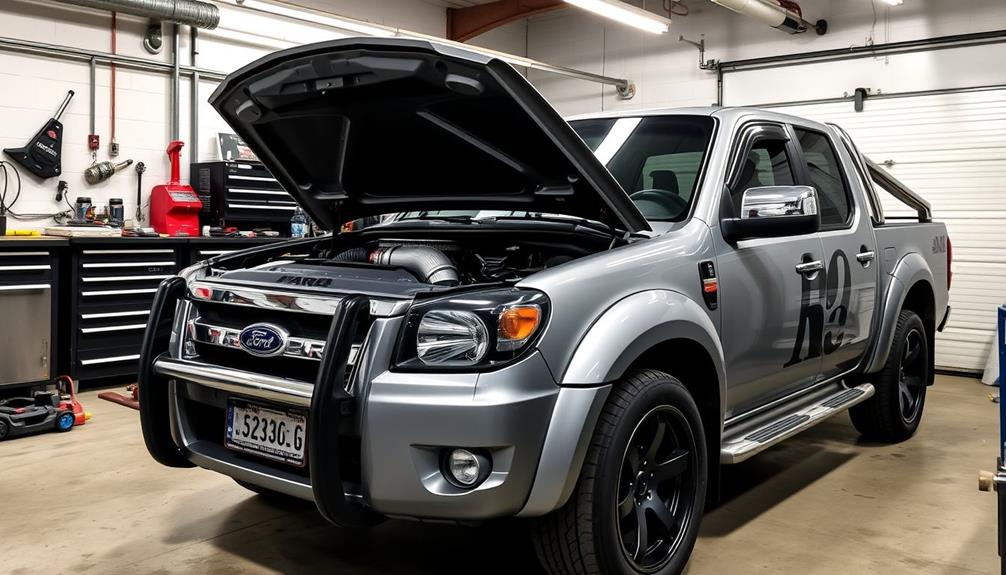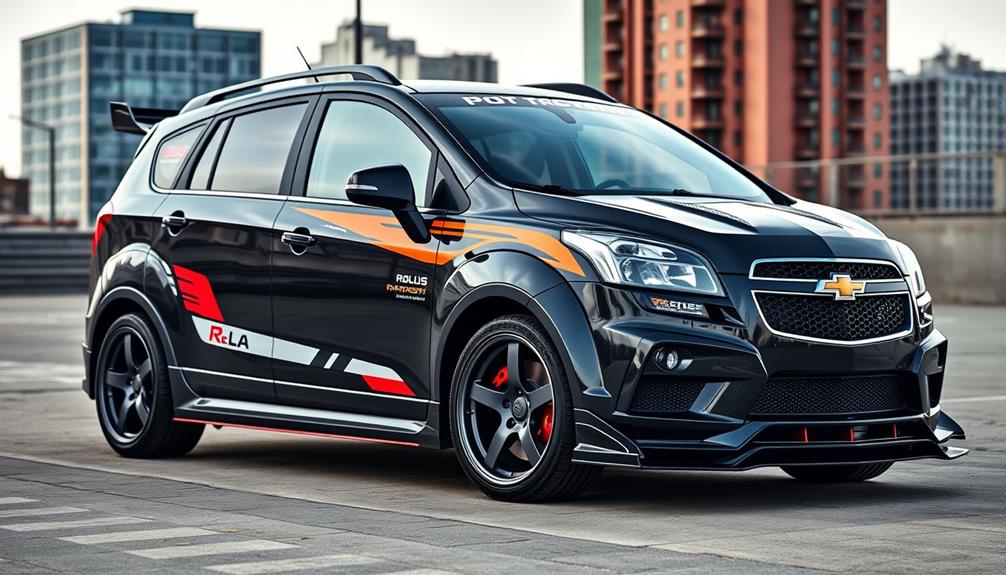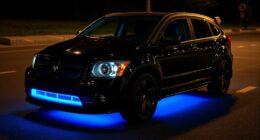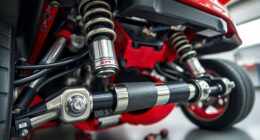Boosting the power of your 2008 Ford Ranger can be an exciting project. Start by upgrading your cold air intake and exhaust system to improve airflow and enhance horsepower. Consider installing SCT tuners for performance enhancement without losing factory settings. A shift kit can enhance transmission responsiveness, making your rides feel sportier. Don't forget about weight reduction; shedding a few pounds can improve fuel economy and driving dynamics. For even more tips and tricks on tuning your Ranger and achieving peak performance, there's plenty more to discover.
Key Takeaways
- Upgrading to a cold air intake and exhaust system can significantly enhance airflow and increase horsepower by 10-15 units.
- Utilizing SCT tuners optimizes engine performance while maintaining factory settings for a reliable boost in power.
- Installing a shift kit improves automatic transmission responsiveness, providing quicker shifts and better acceleration.
- Weight reduction through removing excess cargo can improve fuel economy by 1-2% for every 100 lbs shed.
- Aftermarket coilovers and quality struts enhance handling, stability, and off-road capabilities for a better driving experience.
Engine Performance Enhancements
When it comes to boosting your 2008 Ford Ranger's engine performance, there are several effective enhancements you can consider. One of the most impactful upgrades is installing a cold air intake, like the cleanable gauze filter from Spectre. This modification improves airflow, potentially increasing horsepower and giving your Ranger a more vigorous response.
Next, consider utilizing SCT tuners. They outperform traditional programmers, such as Jet, by effectively storing factory settings while optimizing engine performance. This guarantees you get the most out of your upgrades.
While focusing on performance, don't forget about your exhaust system. Maintaining backpressure is essential; an exhaust system with a diameter that's too large can actually hinder performance. A well-balanced system will enhance your engine's efficiency.
Additionally, implementing underdrive pulleys can greatly boost power output and efficiency in your Ranger's engine setup. These pulleys reduce the load on the engine, allowing it to perform better.
Transmission and Drivetrain Modifications

When tuning your 2008 Ford Ranger, considering transmission and drivetrain modifications can take your performance to the next level.
Upgrading to a shift kit enhances responsiveness, while swapping to an 8.8-inch rear end opens up better gear options.
Don't forget to evaluate differential choices to maximize torque and acceleration without sacrificing fuel economy.
Shift Kit Options
Enhancing your driving experience with a shift kit can greatly elevate the performance of your 2008 Ford Ranger's automatic transmission. Shift kit options improve shift firmness and responsiveness, making acceleration feel more powerful and engaging. For instance, Hurst offers a performance shifter that tightens shifts, providing a sportier feel.
Installing a shift kit is particularly beneficial if you're planning to modify your Ranger for increased power, such as turbocharging. It reduces shift time and boosts gear engagement, essential for handling the extra torque. Additionally, a well-installed shift kit can help mitigate transmission slippage and prolong your transmission's life under performance conditions.
Here's a quick comparison of some popular shift kit options:
| Brand | Type | Benefits | Compatibility | Price Range |
|---|---|---|---|---|
| Hurst | Performance Shifter | Tighter shifts, sporty feel | 2008 Ford Ranger | $250 – $350 |
| B&M | Shift Improver | Faster shifts, better engagement | 2008 Ford Ranger | $200 – $300 |
| TransGo | Shift Kit | Enhanced control, reduced slippage | 2008 Ford Ranger | $150 – $250 |
| TCI | Street/Strip | Versatile performance | 2008 Ford Ranger | $300 – $400 |
| AIRAID | Quick Shift | Quick response, improved performance | 2008 Ford Ranger | $180 – $280 |
With these options, you can tailor your Ranger's performance to fit your driving style.
Rear End Upgrades
Upgrading the rear end of your 2008 Ford Ranger can considerably boost its performance and handling capabilities.
One of the best options is to swap in an 8.8 rear end from an extended cab Ranger. This upgrade offers a wider range of gear options compared to the stock 7.5 rear end, allowing for enhanced customization.
Here are some key upgrades you should consider:
- Limited Slip Differential: This can be added to the stock 7.5 rear end, improving traction and handling in various conditions.
- Lower Gear Ratios: You can install ratios as low as 5.13 for improved acceleration, though be mindful that this might impact fuel economy.
- Shift Kits: Installing a shift kit for your 5-speed automatic transmission can enhance shift response. Brands like Hurst offer performance-focused options.
- Evaluate Transmission Strength: If you're planning to turbocharge, make sure your transmission can handle the increased power to avoid premature failure.
Differential Considerations
While considering differential modifications for your 2008 Ford Ranger, it's crucial to evaluate how changes to the drivetrain impact overall performance and reliability. The stock rear end is likely a 7.5-inch, but upgrading to an 8.8-inch rear end from extended cab Rangers can greatly enhance your options for gear ratios.
With the 8.8, you can go as low as 5.13, which improves torque and acceleration, though keep in mind that lower ratios might negatively affect fuel economy.
If you're sticking with the 7.5-inch rear end, consider a limited slip differential. This upgrade enhances traction and handling during acceleration, giving you more control on the road.
As you boost power—say, through turbocharging—don't overlook the importance of upgrading the transmission. It needs to handle the added stress to maintain reliability.
Additionally, incorporating shift kits, like those from Hurst, can drastically improve the responsiveness of your Ranger's 5-speed automatic transmission. These kits allow for tighter and quicker shifts, ensuring you maximize the benefits of your differential considerations.
Fuel Economy and Efficiency

When it comes to fuel economy in your 2008 Ford Ranger, you'll notice a difference between winter and summer MPG.
Reducing weight by removing unnecessary items can boost efficiency, while a proper engine tune-up keeps your performance sharp.
Understanding these factors can help you make informed choices to enhance your Ranger's fuel efficiency.
Winter Vs. Summer MPG
Understanding the differences in fuel economy between winter and summer can help you make informed decisions for your Ford Ranger.
When it comes to winter vs. summer MPG, you'll notice a significant drop in efficiency during colder months. Typically, you'll see about 20 MPG in winter conditions, mainly due to colder temperatures and increased heating demands. In summer, your Ranger can achieve closer to 23 MPG, thanks to milder weather and more efficient fuel blends.
Here are some tips to maximize your fuel economy across seasons:
- Upgrade Tires: Stock tires can hurt your highway MPG. Consider investing in more suitable tires for better efficiency.
- Remove Excess Weight: Shedding around 150 lbs of unnecessary cargo can lead to noticeable improvements in fuel economy.
- Regular Tune-Ups: Keeping your engine well-maintained guarantees peak performance and better MPG results.
- Use Summer Blend Gasoline: This can enhance fuel efficiency during warmer months.
Weight Reduction Benefits
Reducing weight in your 2008 Ford Ranger can have a significant impact on fuel economy and overall efficiency. By eliminating excess weight—like removing 150 lbs of sand—you can see notable improvements, especially during highway driving.
On average, your Ranger might achieve 20 MPG in winter and 23 MPG in summer, so weight reduction benefits are even more pronounced in warmer conditions.
Lighter vehicles not only enhance acceleration but also improve handling, leading to a better driving experience. Studies indicate that for every 100 lbs you remove, you could improve fuel efficiency by approximately 1-2%. This means that shedding just a bit of weight can translate to noticeable gains at the pump.
Moreover, maintaining a lower weight doesn't just boost your MPG; it also reduces strain on your engine and drivetrain. This can potentially extend the lifespan of these crucial components, saving you money in the long run.
Engine Tune-Up Importance
Maintaining your 2008 Ford Ranger isn't just about reducing weight; regular tune-ups play an essential role in optimizing fuel economy and efficiency. During these tune-ups, tasks like changing the air filter, spark plugs, and fluids can help your engine run more smoothly, ultimately improving fuel efficiency. Additionally, checking the tire pressure and alignment can minimize rolling resistance, further enhancing performance. Similar maintenance practices can also boost power in Ford F150 2009 models, ensuring they operate at peak efficiency while delivering reliable power on the road.
An engine tune-up is vital for enhancing your vehicle's performance, allowing you to experience better power and efficiency while driving. Here are some key benefits of regular tune-ups:
- Improved Fuel Economy: Users report winter MPG of 20 and summer MPG of 23, highlighting significant gains through consistent maintenance.
- Enhanced Engine Responsiveness: A well-tuned engine offers better throttle response, especially important for the Duratec engines, which achieve superior MPG compared to Lima engines.
- Weight Management: Removing excess weight, like 150 lbs of sand, can further improve fuel efficiency, emphasizing the importance of regular tune-ups alongside weight reduction.
- Fuel Quality Matters: Using summer blend gasoline in conjunction with tune-ups can lead to even better fuel efficiency, showcasing the importance of fuel quality.
Community Insights and Resources

Immerse yourself in the vibrant community surrounding Ford Ranger tuning, where enthusiasts share invaluable insights and resources. Websites like Rangerpowersports.com serve as hubs for discussions on aftermarket performance parts, helping you make informed decisions about your upgrades.
You'll find threads packed with information on modifications like exhaust systems and air intakes, highlighting the importance of researching existing discussions before posting any questions.
Many users report significant performance gains, especially when switching from Lima to Duratec engines, and this community plays a vital role in sharing tips on enhancing both engine efficiency and power output.
You'll discover recommendations for specific brands and products based on personal experiences, which fosters a collaborative environment for sharing successful tuning strategies.
As you dive deeper, you'll notice that the community encourages everyone to share their results after implementing enhancements. This collective sharing contributes to a wealth of knowledge that's beneficial for both novice and experienced tuners.
I'm still amazed at how supportive this community is, and you'll likely find the insights you need to take your Ford Ranger's performance to the next level.
General Advice and Considerations

When considering performance modifications for your 2008 Ford Ranger, it's vital to define your goals clearly. This will help you achieve a balance between enhanced power and practicality.
Here's some general advice and considerations to keep in mind:
- Define Your Purpose: Are you looking for improved towing capacity, better fuel efficiency, or more off-road capability? Knowing your primary goal can guide your choices.
- Research Before You Buy: Avoid unnecessary modifications that could lead to performance losses. Look into existing aftermarket parts and their effectiveness to make informed decisions.
- Compliance Matters: Maintaining factory settings is essential for compliance with emissions regulations. This also guarantees you can receive continued dealer service support without complications.
- Think Resale Value: Consider how your modifications might affect the resale value of your Ranger. Some upgrades can enhance appeal to future buyers, while others may detract from it.
Airbox and Intercooler Upgrades

Upgrading the airbox and intercooler on your 2008 Ford Ranger can greatly enhance your truck's performance and responsiveness. By replacing the factory airbox, you can improve airflow, which may yield an increase of up to 5 horsepower. Additionally, removing the factory restrictor from the airbox further boosts airflow, contributing to even better engine performance.
Switching to an aftermarket aluminum intercooler can offer a performance increase of around 9 kW at the wheels while enhancing durability and cooling efficiency. This is particularly important if you often tow heavy loads. Aftermarket intercoolers vary in price from $280 to $1,500, but the investment pays off with improved intake air temperatures, ensuring your engine runs smoothly under strain.
Combining these upgrades not only supports your truck's reliability but also maximizes its capability in demanding driving conditions.
With both the airbox and intercooler enhancements, you'll notice a significant overall boost in performance. So, if you're looking to get the most out of your Ranger, investing in these air intake upgrades is a smart move that can lead to a more powerful and responsive driving experience.
Exhaust System Improvements

A high-performance exhaust system can make a noticeable difference in your 2008 Ford Ranger's overall performance. By upgrading to a full 3-inch exhaust system, you can greatly reduce backpressure, leading to enhanced horsepower and performance.
Here are some key improvements you should consider:
- High-Flow Catalytic Converter: Installing this alongside your new exhaust boosts exhaust flow while keeping emissions compliant, which is much better for the environment.
- Aftermarket Options: The factory exhaust is often restrictive, but replacing it can yield gains of 10-15 horsepower, depending on your setup.
- Performance Muffler: Using a quality muffler designed for performance optimizes exhaust flow and sound, enhancing your driving experience without losing power.
- Regular Maintenance: Checking for leaks and blockages is essential to guarantee peak performance and longevity of your tuning modifications.
Suspension and Handling Enhancements

Enhancing your 2008 Ford Ranger's suspension and handling can dramatically transform your driving experience, whether you're tackling tough terrain or cruising on the highway.
If you're looking to add performance, consider upgrading to aftermarket coilovers, like Bilstein. They'll considerably enhance your suspension performance and provide improved handling along with increased lift for off-road capabilities.
If you prefer a sportier drive, installing a lowering kit can help. Dropping your Ranger by 1.5 to 2 inches lowers the center of gravity, boosting handling dynamics without sacrificing comfort.
You should also replace factory struts with high-quality aftermarket options; this prevents premature wear and improves overall responsiveness, giving you a more stable driving experience.
Looking to add durability? Upgrade to steel link pins instead of plastic alternatives to enhance the reliability of your suspension components, especially during heavy use or off-road adventures.
Finally, if you're lifting your Ranger over 3 inches, confirm proper camber correction to avoid negative offset, which can lead to uneven tire wear and improved traction.
These enhancements will make a noticeable difference in how your Ranger handles on any surface.
Frequently Asked Questions
How Can I Make My 4.0 Ford Ranger Faster?
To make your 4.0 Ford Ranger faster, consider upgrading to a cold air intake, installing a performance exhaust system, using an SCT tuner, and incorporating an underdrive pulley for better power and efficiency.
How to Make a 2.3 L Ranger Faster?
To make your 2.3L Ranger faster, consider upgrading your cold air intake, installing a high-flow exhaust, tuning with SCT, adding an underdrive pulley, and improving traction with a limited slip differential. Enjoy the ride!
What Is the Best Year for Ford Ranger Pickups?
When considering the best year for Ford Ranger pickups, many enthusiasts argue that 2001 stands out due to its reliability, strong engine options, and favorable reviews, especially with the 4.0-liter V6 variant.
What Does the PCM Do in a Ford Ranger?
Did you know that the PCM can adjust engine parameters up to 100 times per second? In your Ford Ranger, it manages fuel injection, ignition timing, and emissions control to guarantee peak performance and efficiency while driving.
Conclusion
In the world of tuning, your 2008 Ford Ranger can transform from a reliable workhorse to a powerhouse, much like Clark Kent stepping into the phone booth. With the right enhancements, you're not just boosting performance; you're elevating your driving experience to superhero status. Whether it's upgrading the exhaust or fine-tuning the suspension, every tweak brings you closer to the ultimate ride. So gear up, get creative, and release the true potential of your Ranger!










